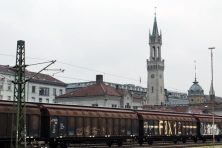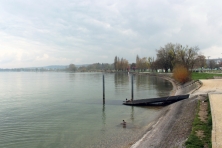2k24
Kreuzlingen/Konstanz (CH/DE) – Runner-up
TEAM DATA
Team Representative: Thibaut Muller (FR) – architect; Associates: Anais Godefroy Rieb (FR), Charles Mannenc (FR) – architects; Hugo Alzingre (FR), Arthur Poiret (FR) – architects urbanists
4 impasse Delauney, 75011 Paris – France
+33 6 49 49 76 63 – contact2K24@gmail.com – cargocollective.com/2k24
See the complete listing of portraits here
See the site page here

A. Godefroy Rieb, C. Mannenc, A. Poiret, H. Alzingre and T. Muller
INTERVIEW
1. How did you form the team for the competition?
We are all of the same promotion of the Architecture School in Strasbourg. We know and appreciate each other’s work and naturally teamed up for the Europan competition. Nowadays, every one of us works in a particular field: architecture, urban planning and organization of festivals. We are passionate, from the smallest scale to the largest, from crafting furniture to analyzing a territory or a landscape... These complementary visions and approaches created a multidisciplinary team gathered around the same passion: architecture.
2. How do you define the main issue of your project, insisting on how you answered on this session main topic: adaptability and urban rhythms?
The cities –Kreuzlingen in Switzerland and Konstanz in Germany–proposed an atypical place the first intention of which is to reconnect the cities and their dwellers to express the opening of the border. Reading the expectations, we decided to focus the project on a landscape issue as a base for the practices. This problematic tends to reconnect the site both on the large territory –by means of the lake docks– and on the urban scale, searching for links trough the existing city network.
The landscape therefore structures the site and products several entries and paths. It also allows us to be flexible to urban or punctual changes, whether they are long-lasting or temporary. Our project as a whole and more particularly our landscape work try to consider time-related and practical variables. The programs proposed can evolve during the year, the landscape changes over the seasons and the citizen’s habits vary according to the moments of the day. This is how we wanted to develop our vision of adaptability. In conclusion it is a mixed and multicultural area symbolizing the union of both countries.
3. How did this issue and the questions raised by the site mutation meet?
To tackle the problems of the site and the broader issue of adaptability at the same time, we asked ourselves the question of "identity". This identity is based on several scales: it is both the physical connection the project has with the large territory, the city and its inhabitants, but also the relationship between the two municipalities and countries. This identity, both tangible and intangible, therefore evolves over time and we wanted to make a project that represents it but also adapts to it.
Relationships to the city are therefore not constant but change according to time and seasons. Nature reflects the passing time –in constant change– it integrates urban rhythms and adapts according to our projections. We placed this nature at the center of the project through a landscape strip system, the strips supporting the various programs we propose. These strips offer a multitude of sequences throughout the site and mingle with the strip formed by the border, which is integrated in our work, yet not necessarily erased. Finally, the site itself sets itself as a sequence, on a larger scale along the docks of the lake, offering a unique park that symbolizes the two cities.
Our project indeed definitely makes sense through this strip system. We used the ambivalence –or actually the paradox– between the concept of adaptability and our work, framed as a grid. Though rigid, this basis can accommodate programs that slide and change with the site. The sequences are also the support for different species of trees, plants and flowers that change with the seasons. We imagined the landscape like a painting that is not static but evolves with the days, seasons and years.
Finally, the Festplatz –a major element of the program– takes a symbolic position at the crossroads of both countries and the two major axes of the site, linking both South and North but also the city and the lake. We developed it as a full place within the park. It breaks the landscape system and represents the point around which the park articulates itself. It also is a living place that allows many appropriations by the city and its inhabitants, thereby keeping it alive throughout the year, even outside major events.


4. Have you already treated this issue previously and could you present some reference projects that inspired yours?
The park as an urban structure is a current theme that can be studied in several urban projects on which we have already worked. Still, the site of Konztanz/Kreuzinlen has the rather unique characteristic of sitting over two countries. Our main references were therefore OMA’s proposition for the Parc de la Villette, but also the implementation by Bernard Tschumi on the same site. These extravagances create a unique place within the city of Paris.
5. Today –within the era of an economic crisis and sustainability– the urban-architectural project should reconsider its production method in time; how did you integrate this issue in your project?
As mentioned earlier, our project process develops a paradox. It features a landscape fixed on a rigid framework that is structured and marked by a strip system. Still, the system is flexible and versatile and the strips support programs and landscapes that can slide, develop and evolve according to time, wills or political changes. Besides, the site localization in the city as well as its size offer a great potential for projects. What we, with the team, wanted to propose was to come with a minimum of unmoving and heavy infrastructures and rather consider the large natural environment in the continuity of the docks. The project finally integrates a full public program (cultural and recreational areas, sports facilities but also housing, shops, activities) while leaving the users with a great potential of appropriation.
In a nutshell, the process is based on different complementary layers, articulated around main ideas:
- To connect to the major axes and the city, yet also suggesting the use of narrower and less direct paths;
- A light topography that can accommodate specific programs (bleachers, skate park, etc.) that enrich the landscape;
- The strip system creates sequences and different atmospheres;
- The setting of new programs and preservation of existing programs
6. Is it the first time you have been awarded a prize at Europan? How could this help you in your professional career?
This award for our first participation in Europan motivates us to join other urban and architectural competitions and invites us to go on working together. At the moment we are getting ready and we hope that both municipalities of Konstanz and Kreuzlingen wish to pursue their project and maybe implement it.